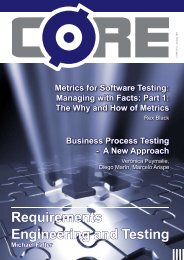Comparison of Change Management Systems
Comparison of Change Management Systems
Comparison of Change Management Systems
Create successful ePaper yourself
Turn your PDF publications into a flip-book with our unique Google optimized e-Paper software.
Quality in Project<br />
Engineering Productivity:<br />
Some ways to measure it<br />
and manage it.<br />
basic<br />
intermediate<br />
advanced<br />
About the author:<br />
Tom is the author <strong>of</strong> nine books, and<br />
hundreds <strong>of</strong> papers on these and related<br />
subjects. His latest book ‘Competitive<br />
Engineering’ is a substantial definition<br />
<strong>of</strong> requirements ideas. His ideas on<br />
requirements are the acknowledged<br />
basis for CMMI level 4 (quantification,<br />
as initially developed at IBM from 1980).<br />
Tom has guest lectured at universities<br />
all over UK, Europe, China, India, USA,<br />
Korea – and has been a keynote speaker<br />
at dozens <strong>of</strong> technical conferences<br />
internationally.<br />
www.gilb.com, twitter: @imTomGilb<br />
Abstract<br />
There are <strong>of</strong>ten too few qualified<br />
engineers. I am mostly referring to<br />
product design engineers – s<strong>of</strong>tware<br />
engineers and systems engineers.<br />
One reason we have too few is that we<br />
misuse their time so badly – we waste at<br />
least 50% <strong>of</strong> it. But when we can longer<br />
desire or afford to solve the problem by<br />
hiring or <strong>of</strong>f-shoring to get more warmbodies,<br />
we need to consider getting<br />
more productivity from the engineers<br />
we already have. There is one great<br />
advantage from that tactic – they already<br />
have plenty <strong>of</strong> experience in our company!<br />
There are several tactics to improve<br />
productivity. They can take many years<br />
to come to full effect, but a steady long<br />
term improvement, and dramatic short<br />
term improvement, should be possible.<br />
The key idea in this paper is that we can<br />
define our own productivity quantitatively<br />
– and manage the improvement <strong>of</strong> it<br />
quite systematically. Your own definition<br />
<strong>of</strong> productivity demands several<br />
simultaneous dimensions <strong>of</strong> productivity.<br />
The definition <strong>of</strong> productivity also requires<br />
substantial tailoring to your organization,<br />
and to its current environment. I am<br />
going to assert that the best short term<br />
measure <strong>of</strong> engineering productivity is<br />
agreed value (requirements) delivered;<br />
and the best long term measure <strong>of</strong><br />
engineering productivity is stakeholder<br />
benefits actually delivered.<br />
The Engineering Productivity<br />
Principles:<br />
Here are some basic suggestions for<br />
a framework for getting control over<br />
engineering<br />
productivity:<br />
1. Subjective Productivity: Productivity<br />
is someone’s subjective opinion <strong>of</strong> what<br />
values we want to create for our critical<br />
stakeholders.<br />
2. Measurable Productivity: Productivity<br />
can be defined as a set<strong>of</strong> quantified and<br />
Author: Tom Gilb<br />
measurable variables.<br />
3. Productivity Tools: Productivity can<br />
be developed through the individual<br />
competence and motivation, the way we<br />
organize people, and the tools we give<br />
them.<br />
4. Avoid Rework: The initial attack on<br />
productivity improvement should be<br />
reduction <strong>of</strong> wasted effort<br />
5. Productive Output: The next level<br />
<strong>of</strong> attack on productivity should be to<br />
improve the agreed value delivered to<br />
stakeholders.<br />
6. Infinite Improvement: Productivity<br />
improvement can always be done: there<br />
are no known limits.<br />
7. Perfection Costs Infinity: Increasing<br />
system performance towards perfection<br />
costs far more than increasing volume <strong>of</strong><br />
system function.<br />
8. Value Varies: Product attributes are<br />
viewed and valued quite differently even<br />
by members <strong>of</strong> the same stakeholder<br />
group.<br />
9. Practice Proves Productivity: You<br />
cannot be sure how well a productivity<br />
improvement strategy will work until you<br />
try it in practice.<br />
10. Productivity Dwindles: Yesterday’s<br />
winning productivity tactic may not<br />
continue to work as well forever.<br />
Defining Productivity<br />
Let me tell you what I think productivity is,<br />
maybe even what ‘engineering’ is.<br />
17



